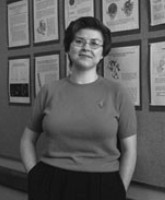非常抱歉,
你要访问的页面不存在,
非常抱歉,
你要访问的页面不存在,
非常抱歉,
你要访问的页面不存在,
验证码:

职称:Professor of Medicinal Chemistry Professor of Chemistry
所属学校:University of Michigan-Ann Arbor
所属院系:Department of Chemistry
所属专业:Chemistry, General
联系方式:734.615.6841
In my research, quantum mechanics, statistical mechanics, molecular mechanics, and database mining techniques are used to investigate chemical and enzymatic systems of biomedical importance. Structure-function relationships and enzymatic regulation often result from subtle details at the atomic level; this detail is beyond the scope of current experimental methods for biological systems. Understanding enzymatic control allows us to explain the mechanism of disease and suggest routes for inhibition. Our research focuses primarily on protein-ligand recognition, protein flexibility, and new methods for computer-aided drug discovery. One of the major projects in my lab is the development of a method for incorporating protein flexibility into the drug design process. A particular breakthrough with this method is that unbound, apo protein structures can be successfully used in drug design. If the community does not need to wait for ligand-bound crystal structures, we can tackle important systems years earlier than previously possible. This research is funded by the NIH. The other major project in the lab is the continued curration of the largest database of protein-ligand complexes: Binding MOAD (Mother of All Databases) and CSAR (Community Structure-Activity Resource). MOAD continues to grow with the PDB, and CSAR is developed with depositions of protein-ligand data from the pubic and private sectors. Websites for CSAR are coming soon. MOAD is currently available online (www.BindingMOAD.org), and we continue to develop web-based tools that allow other users to pull information from our dataset. The patterns within this dataset allow us to better understand the molecular recognition behind ligand-binding events. This research is funded by the NSF and NIH.
In my research, quantum mechanics, statistical mechanics, molecular mechanics, and database mining techniques are used to investigate chemical and enzymatic systems of biomedical importance. Structure-function relationships and enzymatic regulation often result from subtle details at the atomic level; this detail is beyond the scope of current experimental methods for biological systems. Understanding enzymatic control allows us to explain the mechanism of disease and suggest routes for inhibition. Our research focuses primarily on protein-ligand recognition, protein flexibility, and new methods for computer-aided drug discovery. One of the major projects in my lab is the development of a method for incorporating protein flexibility into the drug design process. A particular breakthrough with this method is that unbound, apo protein structures can be successfully used in drug design. If the community does not need to wait for ligand-bound crystal structures, we can tackle important systems years earlier than previously possible. This research is funded by the NIH. The other major project in the lab is the continued curration of the largest database of protein-ligand complexes: Binding MOAD (Mother of All Databases) and CSAR (Community Structure-Activity Resource). MOAD continues to grow with the PDB, and CSAR is developed with depositions of protein-ligand data from the pubic and private sectors. Websites for CSAR are coming soon. MOAD is currently available online (www.BindingMOAD.org), and we continue to develop web-based tools that allow other users to pull information from our dataset. The patterns within this dataset allow us to better understand the molecular recognition behind ligand-binding events. This research is funded by the NSF and NIH.